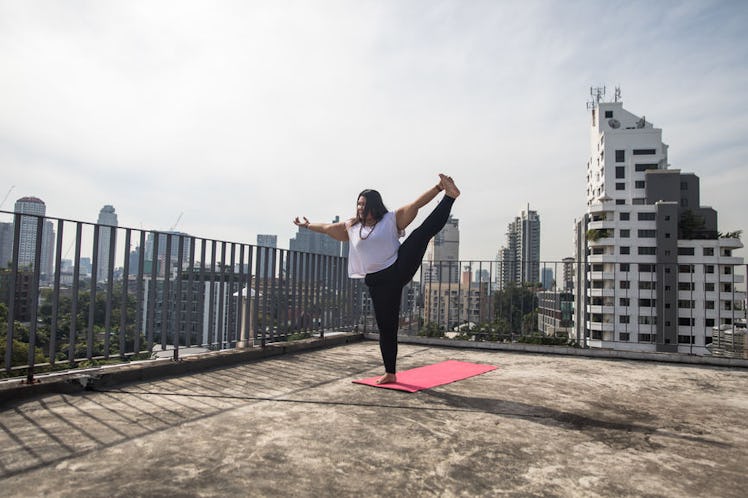
Here's What You've Been Getting Wrong All This Time About What It Takes To Be Flexible
When you see a flexible person in a pretzel-like pose, it looks awesome AF, and you probably wish you, too, could become a human version of a salted and twisty carbohydrate. But what might immediately go through your mind after you see someone who's super flexible, is something along the lines of, "LOL, I can't even touch my toes," or you might just assume the person had to have been "born flexible," whatever that even means. If this rings a bell, then you, my friend, have likely bought into one of the many myths about flexibility that actually aren't true at all. To set the record straight once and for all, anyone can be flexible — with a little patience, and a lot of practice.
Astrid Swan, personal trainer and Premier Protein ambassador, believes everyone has the potential to be as flexible as they want to be — as long as they're willing to work at it — and that the skill is actually more important than people realize for going about normal, day-to-day activities. "We need flexibility to do simple, daily tasks, like getting out of a car, picking up something from the floor, reaching over our heads," Swan tells Elite Daily. "What happens as we get older is we end up in jobs that keep us stationary, which means our muscles get stiff and the joint mobility range lessons. Flexibility comes with staying active and continuing to stretch."
If you really want to start reaping the benefits of flexibility, Swan recommends working on it every day in some capacity, even if all you have time for some days is a quick, five-minute stretch.
But for now, let's debunk some of the flexibility myths that might be holding you back from beginning your journey toward becoming a bendier human.
01You Have To Be "Born Flexible"
Yes, some people are naturally more flexible than others, but that doesn't mean they're the only ones who will ever be able to touch their toes or do a split. "I hear people say all the time that they have never been flexible or can’t even touch their toes," Swan says. "Well that is, in fact, a lie! When we are born, we not only can touch our toes, but we can put our feet in our mouth!"
She's got a point, guys. Flexibility is just one of those things that you have to continue working on throughout your life if you really care about maintaining it, Swan tells Elite Daily.
02You Have To Hold Each Stretch For At Least A Minute
I don't know where the heck this one came from, but according to Swan, you definitely do not need to hold stretches for a longer period of time in order for them to be more effective. "[Stretching for flexibility] can be as simple as doing gentle stretches while still lying in bed in the morning," she says, "such as pulling your knees up to your chest, dropping them side to side, extending one leg out and switching."
Swan also tells Elite Daily that going to yoga classes is a great way to increase your flexibility, if that's something you're into. "Don’t worry if you have never done yoga before," she advises. "It is a practice for the individual and is not a competition." Did you hear that? No comparing yourself to the dude who's touching his feet to his head in a handstand on the mat next to you. ~Everyone's on their own journey~ (seriously though).
03Stretching Prevents Injury
According to a 2011 study presented at the 2011 Annual Meeting of the American Academy of Orthopaedic Surgeons, just because you stretch on the reg and maintain consistent flexibility, doesn't necessarily mean you're never going to get injured. There are many factors that can contribute to any workout-related injury, and even the bendiest of people get sidelined sometimes due to pesky muscle imbalances and failure to warm up properly before exercise.
However, stretching regularly will make your muscles less prone to common injuries. According to Greatist expert and trainer Kelvin Gary, your "risk can be minimized by stretching regularly," though it's not a foolproof sort of thing.
04You Only Have To Stretch The Muscles That You Want To Be More Flexible
You might think, if you want to have more flexible hips, you obviously just have to stretch your hip flexors — right? Well, not necessarily. All muscles in the body are connected in some way, so for example, lower-back stretches, though they target one muscle group, could still be great for opening up (and even eliminating pain in) your hips, aka a slightly different set of muscles.
Try not to discriminate against muscle groups when you're working on your flexibility Stretch it out all over, from head to toe, because a well-rounded, balanced body is key to becoming the bendiest gal around.
05If You're Naturally Flexible, Then You Don't Need To Stretch
Again, there are definitely the naturally flex-y people of the world out there, but even they get less flexible than their full, pretzel-esque potential when they don't keep up with their stretching routine.
According to Swan, it's important for everyone, no matter how flexible you are, to consistently do dynamic stretches before a workout and static stretches after, to keep muscles warm, happy, bendy, and injury-free.
Maybe she's born with it? Nah, fam. Maybe it's consistency, dedication, practice, and commitment.